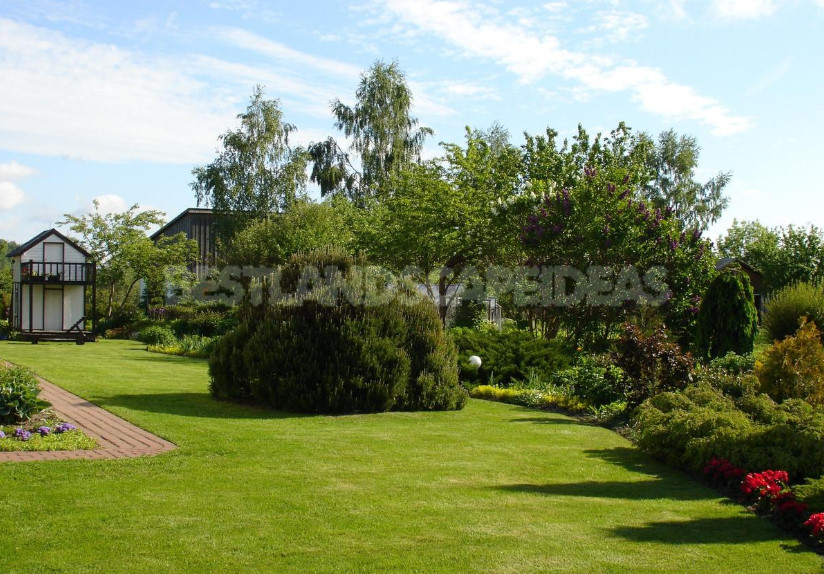
A flower garden arranged without a lawn is the same as a picture without a frame. However, if desired, you can turn the lawn into a picture.
I will not be mistaken if I say that now almost every owner of even a small six-flow plot already has a green lawn or dreams of creating it. Green lawn grass pleases the eye, calms the nervous system, and most importantly — the lawn creates its own microclimate. Freshly cut grass intensively evaporates moisture, increasing the humidity of the surface layer of air. That’s why on the lawn so I want to lie on a hot Sunny day: grass temperature on 5-7 degrees lower than black ploughed soil of vegetable beds and flower borders.
How to choose an ensemble of herbs
Before buying grass seeds for sowing, decide what lawn you need on the garden plot.
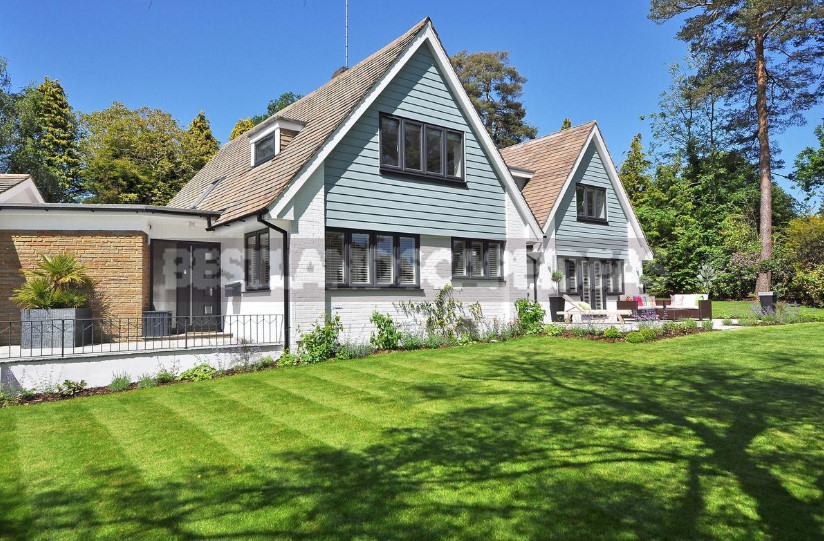
In front of the house in the Central part of the plot, around a small decorative pool, near the sculptural groups create a parterre lawn. Herbs for it are selected with narrow beautiful leaves, with thin stems, with intense tillering after each mowing. These requirements are met by different types and varieties of Agrostis.
Agrostis capillaris has thin, spear-shaped leaves. This species has the most modest requirements for soil conditions. In natural conditions it grows well on sandy alluvia in the floodplains. Agrostis stolonifera forms except underground rhizomes, and even above-ground, rooting and spreading widely after mowing.
The second most important cereal on the lawn – Poa pratensis. The plant is grassroots, rhizomatous, on the lawn can live 25 years or more. Abundantly bushes, forms a set of shortened vegetative shoots, can withstand repeated mowing (up to 12 or more times per season). It’s a great lawn plant.
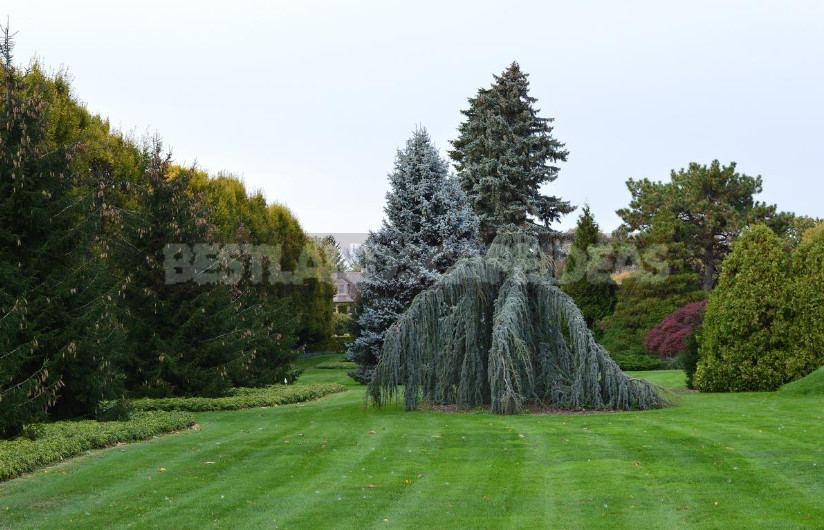
It forms an excellent thick, bright green and sports ground lawns with a very durable sod. Quickly rises: at a temperature of +18…+20 degrees shoots appear on 5-7 days after sowing (using specially prepared seeds). For this purpose, we moisten a mixture of seeds with small, thin sawdust of wood (1: 5) with a weak solution of potassium permanganate (0.1%) or 1% solution of copper sulfate. So we simultaneously disinfect the soil for sowing and weigh down the volatile mixture, which allows us to sow the lawn even in windy weather.
Festuca rubra is one of the best lawn plants. This grass-roots grass with slender stems, narrow leaves creates even in a pure stand of dense grass carpet. Widely used and Lolium perenne.
“Wild” lawn
If you do not really like once or even twice a week to mow your albeit miniature parterre lawn, and the memories of how unpresentable it looked after hibernation, suggest sad thoughts about the futility of their own efforts, the alternative may be the idea of creating a flowering lawn.
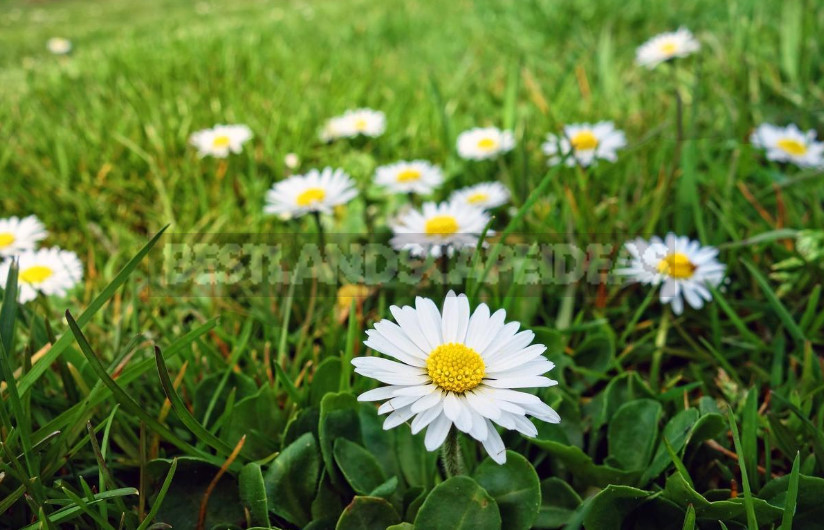
Sometimes such lawns are called natural or “wild”. Fashion for them came to us from England, famous for its lawns, green all year round.
How to do it
According to the existing lawn, created by all the rules (that is, with drainage, light mechanical composition of the top layer of soil and specially selected grass mixture), planted singly perennials, mainly bulbous, which later, growing, create beautiful compositions. This type of flower has previously been the most typical for green grass and lawn landscape style. Now it is always recommended for a forest corner in the suburban area.
On a plain, good quality lawn carefully planted low perennials short term beautiful flowering, which do not develop powerful foliage and do not have creeping stems. After a short flowering, until the lawn grass is restored after the winter, these plants should disappear without disturbing the quality of the lawn.

Scilla, Crocus, Galanthus, Botanical Narcissus, ranotsvetuschie tulips, as well as varieties from the group simple early are recommended for the device of may flowering lawns. Look good on the lawn Bellis perennis, Primula, Anemone, Viola odorata and Viola cornuta, Chionodoxa and others.
These plants are planted in the autumn, which carefully soil drill diameter 5-10 cm make shallow (5-12 cm) planting holes at a distance of 1-1.5 m one from the other. They are filled with fertile soil, poured with a layer of 2-3 cm of river sand or perlite and planted bulbs or rhizomes to a depth equal to three diameters of the bulb, given the bottom. Heat-loving daffodils — 15-20 cm, tulips — 8-10, and crocuses and Scylla — 4-5 cm.
Next spring, even before the full development and regrowth of lawn grass, flowering plants appear most diverse in shape and color of flowers. Single at first, multiplying from year to year, they form flowering nests with 8-20 or more flowers.
Recently entered into fashion and different types of meadow lawns with plants of wild flora characteristic of the area. They are used to create lawns inside the garden and in the forest area of country cottages.
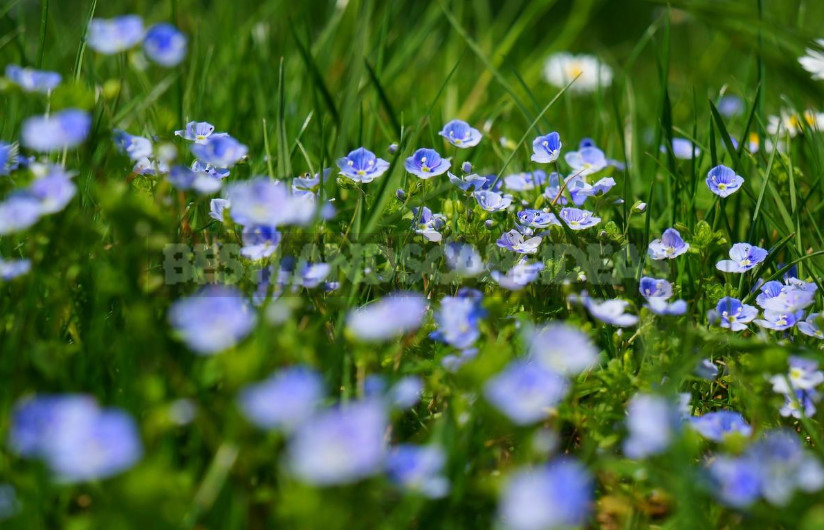
The plot of the garden, designed to create a flowering meadow, in the autumn prepared in the same way as the area under the usual lawn. Soils need light, nutritious, with well-planned drainage. The plot in the planning should get a small slope (5 cm by 10 m length) for water flow without soil erosion.
After the spring planned works, the site is sown with a mixture of lawn herbs, to which the seeds of flower plants are added. The right selection of flowering perennials, easily propagated by seeds, you can create a seasonal change of colors: a spring flowering meadow lawn, laterbecause and lawn, blooming in autumn. The composition of the mixture depends on the climate, soil, geographical location and taste of the owner of the site.
The Moorish flowering lawn
This type of lawn gardeners sometimes perceived as a design novelty, and meanwhile, Moorish lawns were popular with gardeners in the last century.
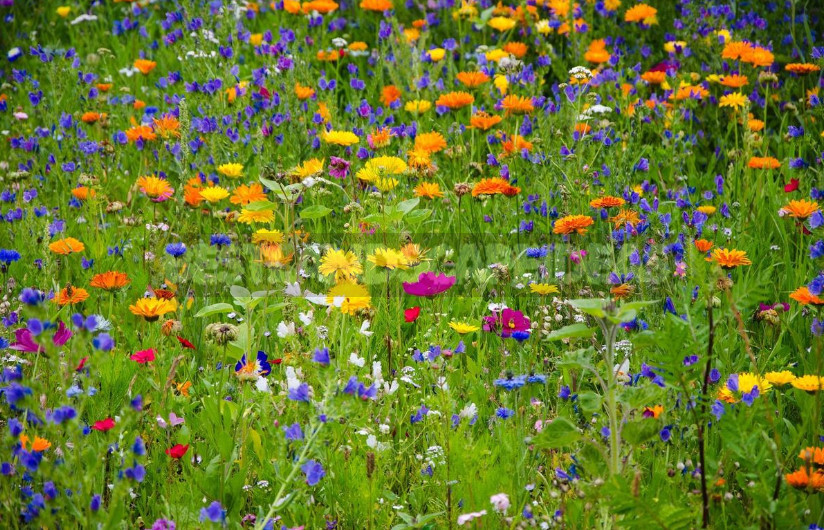
Moorish flowering lawn is made up of the best perennial finest herbs that develop simultaneously in the first year after sowing with a series of diverse in shape and color of annual flowering plants. These latter bloom over the emerald green with a constant flowering colorful carpet from June to frost, and the June series of carpets is replaced in July by plants of a different nature, continuing to bloom until autumn. To all this added a sufficient number of fragrant plants that spread an excellent smell on the distant space.
Full luxury Moorish flowering lawn reaches in mid-summer; after that, if desired, it can be mowed, and then get a great lawn; if mowing is not used, then the next year will also form a great lawn, as all the herbs are only perennial, flowers are annual.
To see the Moorish flowering lawn in front of the house or in remote places of the garden, near the artisanal plantations will undoubtedly be a great pleasure even for a strict lover of gardening, but it is of particular value for people who have neither the time nor the desire to engage in the construction of a country or village garden, since the bare areas planted with this lawn turn, without much cost, into a solid mass of beautiful flowers, around which it remains only to maintain the purity of the paths.
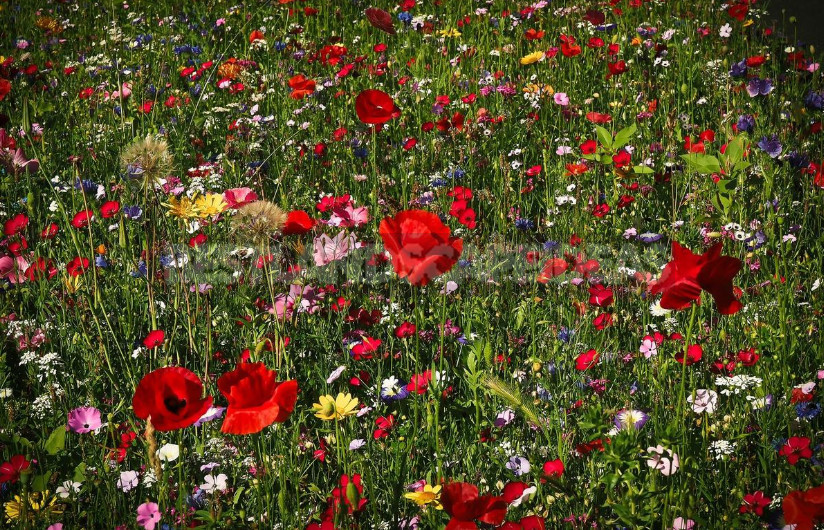
For the full success of sowing Moorish flowering lawn, it should be well to dig the ground to the depth of the shovel and then finely loosen it; remove the roots of weeds and fertilize the land, if it is skinny, old rotted manure – necessary; it is best on the lawns with fresh land.
Sowing is useful to do in the spring, as soon as the ground thaws, if there is a desire and opportunity to cover the seeded places with matting to protect young shoots from spring frosts; in this case, it will bloom in the first days of June. If you make a crop later, about may 8-10, the protection is unnecessary, and flowering will begin in late June. Seeds before sowing, for even seeding, it is necessary to mix well with dry sand (1 part of the seeds 3 parts of the sand); sowing is best to press down to the ground with a Board or roller.
In dry weather, to accelerate the germination of seeds and successful growth of seedlings, watering is necessary; in consequence, the density of greenery significantly keeps the moisture of the land and irrigation can be considered mandatory only in drought. Weeds will certainly pull the weeds, otherwise they choke the seedlings of flowers. We categorically declare that without observing the explained conditions for sowing and caring for the Moorish lawn, it is impossible to count on its successful flowering.


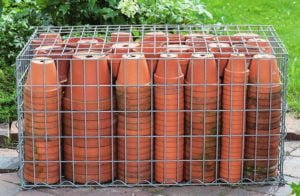

Leave a Reply